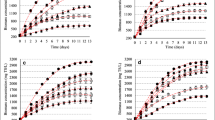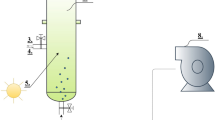Abstract
Wastewater treatment is an important issue because it directly impacts the environment and is directly related to climatic change. However, urban wastewater treatment plants just now cannot complete the treatment from the viewpoint of the circular economy. This work uses the digested liquid generated from the anaerobic digester as culture media to grow the green microalga Chlorella vulgaris. Different culture media at different effluent concentrations are prepared with tap water (5, 10, 25, 35, and 50%, v/v). The experiments were performed in stirred photobioreactors in batch mode with 1L capacity. The common operating conditions used were pH of the culture media = 8, mechanical agitation = 200 rpm, air supply rate = 0.5 L/min, and continuous artificial light at illumination intensity = 359 μE m−2 s−1. The experimental results show that the kinetic growth parameters maximum specific growth rate (0.0204 h−1) and volumetric biomass productivity (0.00860 g L−1 h−1) values were determined in the culture at 25% (v/v) of digested liquid. Furthermore, the wastewater treated quality in terms of removal chemical oxygen demand percentage (26.6%) and total nitrogen removal percentage (94.7%) were determined in the cultures with 50 and 10% (v/v) of liquid digester from wastewater treatment plant (LD-WWTP). The highest net harvest biomass concentration (x–xo = 2.54 ± 0.0155 g/L), total lipid content (13.1%), and %CO2 removal (72.2%) at the end of the cultures were registered in culture operated at 25% (v/v) of LD-WWTP. These results show the possible recovery and recirculation of nutrients from LD-WWTP.
Access provided by Autonomous University of Puebla. Download conference paper PDF
Similar content being viewed by others
Keywords
1 Introduction
Nowadays, nutrient recirculation is one of the most critical challenges in achieving a circular economy to ensure the environment's protection of the globe. Today's wastewater treatment plants (WWTPs) are essential in controlling and handling wastewater treatment. Still, the new climate change challenge requires more transformation and recirculation to achieve sustainability, which means this function is insufficient. Therefore, more nutrient control and recirculation capacity are needed to realize a correct life cycle of raw materials.
Currently, urban sludge generated in the WWTPs is treated through the anaerobic digester to produce biogas. Biogas is normally used for energy generation (as electric energy) and the digester liquid is concentrated for discharge or post-treatment and used as fertilizer or soil conditioner. Then, the liquid obtained is recirculated to the head of the WWTP. The anaerobic digestion process is based on the complex hydrolyzation of organic matter into soluble monomers, such as amino acids, fatty acids, sugars, and glycerol (Volschan-Junior et al., 2021). Then, this residue is rich in many organic and inorganic compounds, which could be used for microalgal growth.
This research aims to study the viability of liquid digester from WWTPs (LD-WWTPs) to use as a substrate for forming culture media for Chlorella vulgaris growth. This use allows the recovery of nutrients and the generation of algal biomass with high added value, especially for biofuel production, in addition to the liquid digester treatment.
2 Methods
A green microalga Chlorella vulgaris strain SAG 9.88 was grown in a liquid digester from urban wastewater treatment at different concentrations prepared with tap water (5, 10, 25, 35, and 50%, v/v) as culture media. The cultures have been carried out under natural conditions without prior sterilization of the culture media.
The common operating conditions used were pH of the culture media = 8, mechanical agitation = 200 rpm, air supply rate = 0.5 L/min, and continuous artificial illumination intensity = 359 μE m−2 s−1. All experiments were carried out in stirred photobioreactors with 1 L capacity.
Biomass was generated, and biomass biochemical composition was determined. For biomass concentration (x, g/L), 5 ml of microalgal suspension was centrifuged at 4000 rpm for 10 min. The obtained biomass was washed three times with ultrapure water and measured at 600 nm in a UV–visible spectrophotometer. A linear calibration curve between absorbance and dry biomass was used to determine the biomass dry weight-cell concentration (g/L).
Total pigments (chlorophyll a, b, and carotenoids) were determined by a photo-colorimetric method after extraction with acetone at 90%, as described by Ritchie (2008). The total chlorophylls and total carotenoid contents were calculated according to the equations described by Jeffrey and Humphrey (1975) and Strickland and Parsons (1972), respectively.
At the end of each culture, biomass was separated and dried at 105 °C. Then, the total lipids content was determined. Next, the total lipid content of the biomass was extracted by a micro-Soxhlet extractor using n-hexane as a solvent for 24 h. Finally, the percentage of total proteins was determined as total nitrogen percentage ×6.25 (Becker, 1994).
The following parameters (Hodaifa et al., 2020) were determined for the liquid residue from the urban anaerobic digester (crude, filtered, and treated): pH value, electric conductivity (EC), and turbidity were directly measured by using a pH-meter Crison model GLP 22C, Conductimeter Crison, model GLP31, and Turbidimeter Hanna, model HI93703, respectively. Chemical oxygen demand (COD) was determined photometrically at 620 nm according to German Standard Methods. Total phenolic compounds (TPCs) were performed by making them react with a derivative thiazol, giving a purple azo dye, determined photometrically at 475 nm according to the standard methods. Total carbon (TC), total organic carbon (TOC), total nitrogen (TN), and inorganic carbon (IC) were determined using a Total Carbon and Nitrogen Analyzer provided by Skalar Company, model FormacsHT and FormacsTN. Total iron determination was performed by reducing all iron ions to iron (II) ions in a thioglycolate medium with a triazine derivative. According to the standard methods, this reaction results in a reddish-purple complex that was photometrically determined at 565 nm. Chloride, sulfate, and orthophosphate were determined photometrically at 450 nm, 420 nm, and 690 nm, respectively, according to the standard methods. Sodium, calcium, and potassium were directly determined by using a selective ion electrode for each ion (Crison, mod. GLP 22).
3 Results and Discussion
3.1 Characterization of the Liquid Digester from Urban Wastewater Treatment Plant (LD-WWTP)
Table 1 shows the characterization of tap water (as a control experiment) and filtered liquid digestor from the urban wastewater treatment plant, in addition to characterize this filtered LD-WWTP at different concentrations prepared with tap water (5, 10, 25, 35, and 50%, v/v) before treatment by Chlorella vulgaris. The comparison between tap water and LD-WWTP indicated the high turbidity, COD, TPCs, TC, TOC, IC, TN, NH4, NH3, total-P, Na, K, SO4, Cl, and Fe of LD-WWTP. This high concentration of nutrients could be recovered using this residue for microalgal growth. However, the direct use of LD-WWTP as a culture medium is impossible due to the high osmotic pressure (high nutrient concentration), enabling microalgal cell growth. For this reason, different LD-WWTP concentrations were prepared to study the C. vulgaris growth since the nutrient distribution on the culture media depends on the dilution applied in each case (Table 1).
3.2 C. vulgaris Growth, Bioremediation, and Biochemical Composition
Figure 1 shows the net biomass generation in the different cultures developed from LD-WWTP. In all experiments, approximately a Lag phase with a 100 h duration was observed before the exponential growth phase. Only in the culture at 5% of LD-WWTP, no Lag phase was detected. This may be due to the presence of total phenolic compounds in the culture media that are considered growth inhibitors (Hodaifa et al., 2020).
The highest biomass generation was detected in the culture operated at 25% LD-WWTP with algal biomass concentration up to 2.5 g/L after 358 h. In this sense, ANOVA one-way analysis of variance shows that at the 0.05 level, the population means are significantly different (final biomass concentration mean = 1.18 g/L, F-value = 8.38, and P-value = 0.02004 < 0.05).
The net biomass generation increases by increasing LD-WWTP concentration in the culture media up to 25% (v/v). Then, this concentration is decreased to depreciable concentration at cultures with 50% (v/v) of LD-WWTP (Fig. 1). In Table 2, it can be seen the quality of the LD-WWTP after C. vulgaris growth. A notable improvement in their values was observed for all quality parameters. Cultures at 5 and 10% of the treated LD-WWTP could be discharged directly to the waterways since COD < 125 mg/L, TN, and Total-P < 10 mg/L (Directive 91/271/EEC on Urban Wastewater Treatment).
The final biomass obtained is rich in energetic compounds (carbohydrates + lipids), registering an average value of 66.1 ± 3.15%. The highest total lipid was 13.1% and registered in the culture at 25% of LD-WWTP.
4 Conclusions
The study of using LD-WWTP as a substrate to formulate culture media of Chlorella vulgaris demonstrated the viability of the recovery of nutrients and the possible bioremediation of LD-WWTP before its recirculation to the head of the WWTP. Higher net biomass generation and energetic compounds were obtained up to 3.5 g/L and 66.1 ± 3.15%, respectively. Total lipids up to 13.1% were obtained in the culture with 25% LD-WWTP, which can separate and convert into biodiesel. The carbohydrate fraction could be used for biofuel production. As a bad option, the whole biomass could be introduced to the anaerobic digester for major biogas yield.
References
Becker, E. W. (1994). Microalgae: Biotechnology and microbiology. Cambridge University Press.
Directive 91/271/EEC on Urban Wastewater Treatment.
Hodaifa, G., Malvis, A., Maaitah, M., & Sánchez, S. (2020). Combination of physicochemical operations and algal culture as a new bioprocess for olive mill wastewater treatment. Biomass and Bioenergy, 138, 105603.
Jeffrey, S. W., & Humphrey, G. F. (1975). New spectrophotometric equations for determining chlorophylls a, b, c1 and c2 in higher plants, algae and natural phytoplankton. Biochemie Und Physiologie Der Pflanzen (BPP), 167, 191–194.
Ritchie, R. J. (2008). Universal chlorophyll equations for estimating chlorophylls a, b, c, and d and total chlorophylls in natural assemblages of photosynthetic organisms using acetone, methanol, or ethanol solvents. Photosynthetic, 46, 115–126.
Strickland, J. D. H., & Parson, T. R. (1972) A practical handbook of seawater analysis. Fisheries Research Board of Canada, Bulletin, 167–310.
Volschan-Junior, I., de Almeida, R., & Christe-Cammarota, M. (2021). A review of sludge pretreatment methods and co-digestion to boost biogas production and energy self-sufficiency in wastewater treatment plants. Journal of Water Process Engineering, 40, 101857.
Acknowledgements
The Junta of Andalusia and the University of Pablo de Olavide are acknowledged for financial support through Project Ref.: UPO‐1260312 “Revaluation and reuse of gaseous effluents (gaseous combustion ‘CO2’) and liquids (urban and industrial wastewaters) through the use of advanced oxidation technologies and production of high added-value algal biomass”. The authors also thank the University of Pablo de Olavide for its support through the Bridging Grants for the competition of the State R&D Plan under the Own Research and Transfer Plan 2018–2020, Ref.: RTI2018-101875-B-C22.
|
|
|
Author information
Authors and Affiliations
Corresponding author
Editor information
Editors and Affiliations
Rights and permissions
Copyright information
© 2023 The Author(s), under exclusive license to Springer Nature Switzerland AG
About this paper
Cite this paper
Hodaifa, G., Belaiba, A. (2023). Liquid Digester from Urban Wastewater Treatment Plants for Chlorella vulgaris’ Growth and Nutrient Recirculation. In: Çiner, A., et al. Recent Research on Environmental Earth Sciences, Geomorphology, Soil Science, Paleoclimate, and Karst. MedGU 2021. Advances in Science, Technology & Innovation. Springer, Cham. https://doi.org/10.1007/978-3-031-42917-0_6
Download citation
DOI: https://doi.org/10.1007/978-3-031-42917-0_6
Published:
Publisher Name: Springer, Cham
Print ISBN: 978-3-031-42916-3
Online ISBN: 978-3-031-42917-0
eBook Packages: Earth and Environmental ScienceEarth and Environmental Science (R0)








